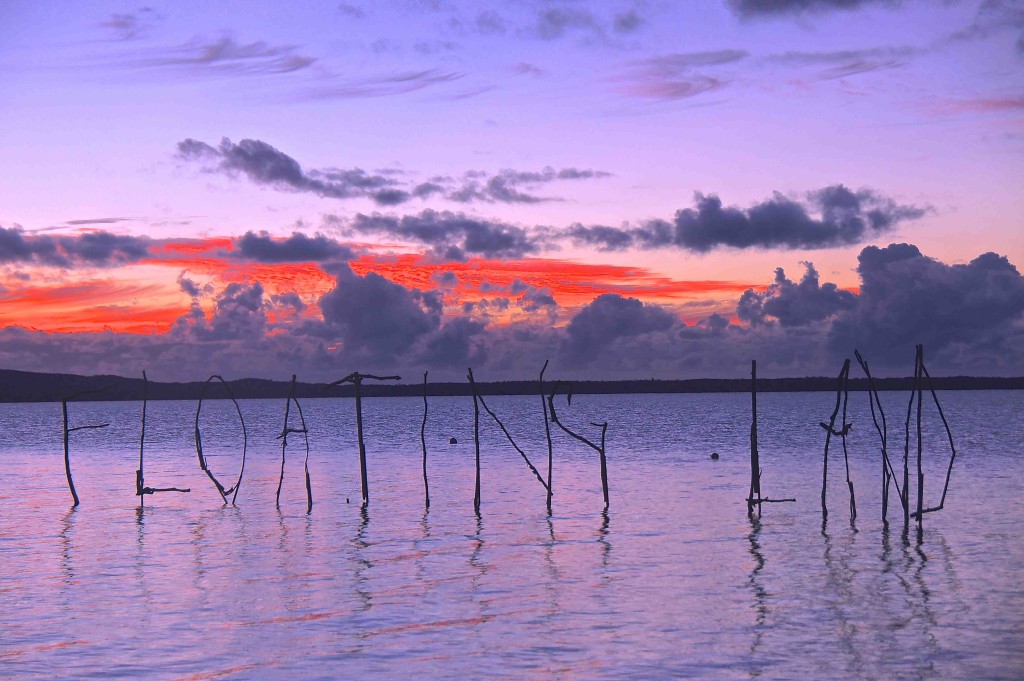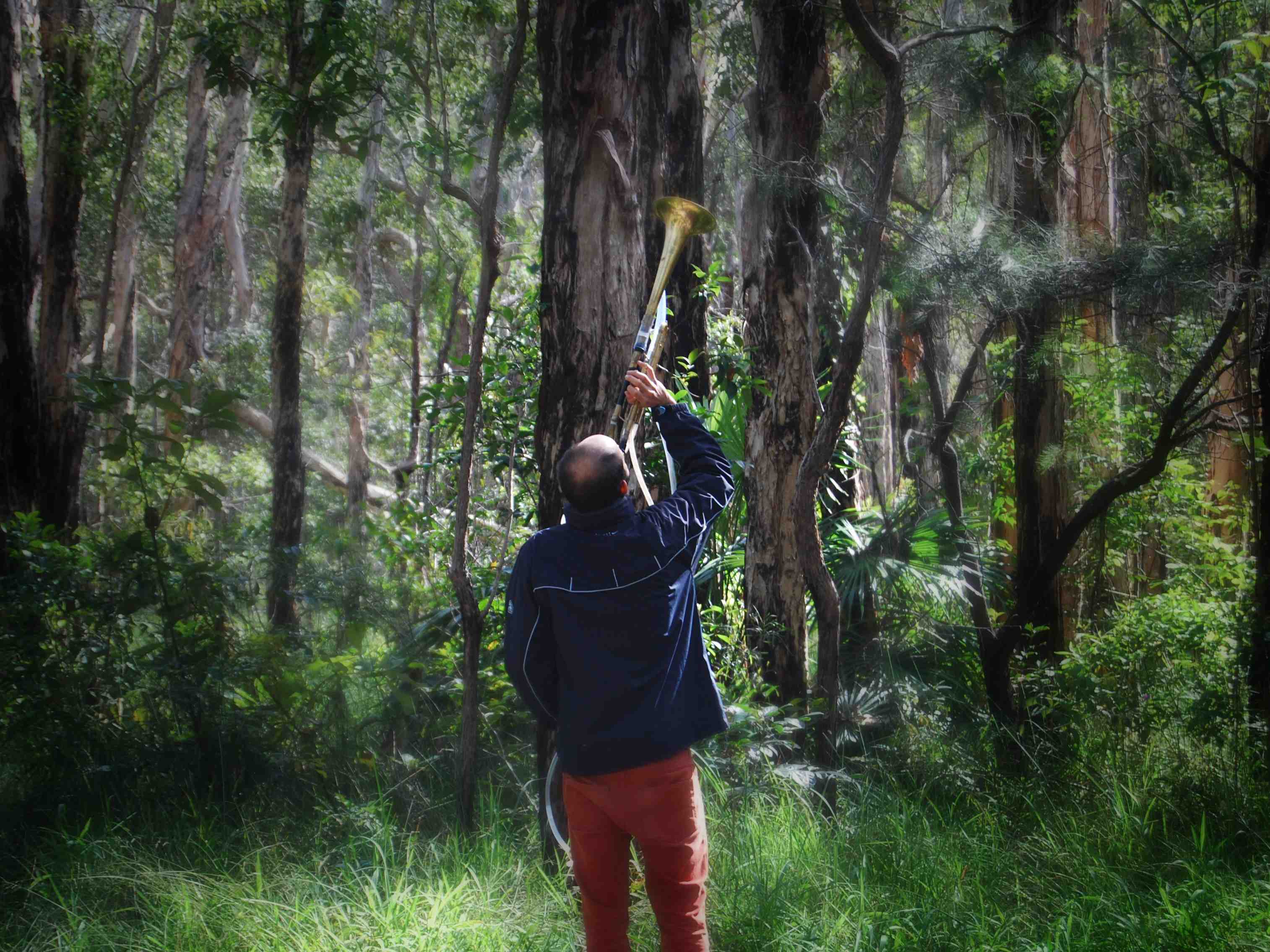
Floating Land is a biennial arts festival hosted in the UNESCO recognised Noosa Biosphere Reserve in Queensland, Australia. Conceived in 2001 as an outdoor sculpture exhibition, the festival has expanded into a dynamic interdisciplinary event commissioning innovative collaborations and hosting local, national and international artists. The festival is now renowned as a key contributor to the international conversation around art and the environment and it’s clear “the curation of experimental and new media art has provided important critical force to this expansion” (Zuvela, 2012).
The core of Floating Land is focused around encouraging environmental awareness through site-specific creative responses and community engagement. While the attention of past events has certainly been the visual arts, the last three iterations of the festival have seen the emergence of projects focused around music, sound and acoustic ecology. The 2013 Floating Land theme “Nature’s Dialogue” was drawn from ‘biomimicry’, bringing the science of nature deeply into the conversation and providing a powerful platform for interdisciplinary thinking and collaborations. This theme inspired a rich body of work and embraced a clear strand of projects focused on the value of listening in our current state of ecological crisis.
The installations and performances at Floating Land are focused on the foreshore of Lake Cootharaba, a shallow and expansive body of water on the Noosa River. One of the initial projects installed onsite in 2013 was Rainwire, a long-term collaboration between artist-scientist David Burraston and artist-curator Sarah Last. Burraston and Last have an international reputation for their work and have been actively pioneering interdisciplinary art practice in rural Australia through their organisation The Wired Lab. Rainwire is a sonification project that explores rain events and intercultural dialogues with this natural phenomenon as a means to better understand rainfall and societies’ relationship with water. The project draws deeply on Burraston’s scientific background and Last’s community practice to create a truly engaging experience that has both creative and scientific implications. Their long-term goal is to develop a functional acoustic rain gauge using a unique landscape scale long wire instrument, essentially a large-scale Aeolian Harp. At Floating Land, Rainwire was realised through the sounds of rainfall falling on long wire instruments as a medium for creative investigation. In addition to installing the wire across the lake, the audience could experience the Rainwire sonificiations from other locations in Australia via listening devices. While the visual appearance of this work offers minimal insight into this rich collaboration, the auditory layers prove this was undeniably one of the most innovative projects presented at Floating Land. It also highlighted the sophisticated progression of art-science collaborations in interdisciplinary practice.
Further along the lake, a captivating soundscape resonated from the tree branches in Lenni Semmelink’s Earthsong installation. Semmelink is an emerging artist who was the recipient of the Noosa Biosphere Art Prize (scholarship) to develop Earthsong for Floating Land 2013. While her practice is grounded in visual arts, her fascination with sound led her to focus around amplifying the bioacoustics of the natural environment. The result was a truly immersive space that allowed the audience to hear the internal soundscapes of the surrounding trees through speakers planted throughout the branches. Semmelink’s work is exemplary in its ability to deliver an accessible and engaging environmental experience aided by technology, a challenging feat for any artist. Interactive layers encouraging audience participation further enhanced the experience of Earthsong, this was facilitated through headphones placed through the trees that were connected directly to hydrophones submerged in the lake and contact microphones planted in the ground. Observing these interactions was in itself a fascinating insight into auditory perception, while some actively played the trees with percussive rhythms others stood in silence as if actively listening for the first time. It’s works such as Earthsong that exemplify the true value of Floating Land; they act as a catalyst for experimentation and push both artists and audiences into new territory to explore our relationship with the environment.
Linsey Pollack’s lakeside performance ‘Cries Across the Water’ was a highlight for many at Floating Land 2013. As the sun set across Lake Cootharaba, Pollack performed solo on his custom electronic wind instrument using live loops of endangered and extinct animals. These samples included the Crested Gibbon, the Black Rhino, Carnaby’s Cockatoo and the Kroombit Tinker Frog. While the sounds were transformed into abstract musical compositions, he introduced each piece with the natural call of the animal along with an explanation of the species and its deteriorating habitat. Pollack is undoubtedly one of Australia’s most innovative musicians and his diverse body of work crosses communities, cultures and disciplines. Pollack’s performances often see him playing unusual objects and assuming comedic characters, yet in contrast ‘Cries Across the Water’ had inherently tragic undertones. Listening to the sounds of extinction is both confronting and moving, yet the artistic integrity of the performance carried a sense of hope through his sensitive interpretations. This performance truly highlighted the value of creativity in gently making us aware and engaged in the catastrophic ecoside we are facing.
Floating Land’s virtual program allowed the curation of projects that were delivered both onsite and online, these included activities that encouraged local and global participation. One example is Biosphere Soundscapes, a large-scale interdisciplinary art project underpinned by the creative possibilities of acoustic ecology. This art-science project is designed to inspire communities across the world to listen to the environment and reimagine the potential of International UNESCO Biosphere Reserves as learning laboratories for a sustainable future. For Floating Land, Biosphere Soundscapes invited a diversity of artists to engage with the soundscapes of Noosa Biosphere through various activities. These included field recording, sound mapping and a barefoot soundwalk led by Anthony Magen from the Australian Forum of Acoustic Ecology. The sound walk guided participants in silence along the lake and through to the surrounding bush land where they were greeted with a live performance from the West Head Project. This extraordinary performance featured acclaimed Australian musicians Jim Denley, Monica Brooks and Dale Gorfinkel weaving sonic responses with the natural soundscapes of Boreen Point.

Biosphere Soundscapes also invited American digital media artist Andrea Polli to facilitate a masterclass with visiting artists and the local community. As a pioneer in the acoustic ecology field, Polli guided her participants through an introduction to acoustic ecology, the aesthetics of field recording and the core theories of her practice. She was accompanied by members of her research lab at the University of New Mexico, who were instrumental in capturing field recordings throughout Noosa Biosphere Reserve to be published on the Biosphere Soundscapes sound map.
Floating Land wouldn’t be complete without the evocative sounds of Lyndon Davis playing didgeridoo, a soundscape that has become synonymous with Floating Land in recent years. Davis is an indigenous artist raised on the Sunshine Coast and is a direct descendant of the local Gubbi Gubbi people, traditional custodians of the land. He is the director of Gubbi Gubbi Dance, who also featured at Floating Land 2013, performing traditional songs and facilitating workshops throughout the ten-day event. Floating Land 2013 also hosted the Leweton Cultural Group from the remote northern tropical islands of Vanuatu who performed traditional songs from Na Mao and Nelang (men’s and women’s kastom dances). The joyful songs of the Leweton group, particularly their transfixing harmonies, provided firsthand insight into a rich culture that still has music and sound engrained in everyday life.
Many of the other performances and installations at Floating Land had strong sonic components, ranging from the evocative soundscapes of Michel Tuffery and James Muller’s installation to the DAM(N) Project, an interdisciplinary dance performance with a score composed entirely of environmental field recordings from India. The rich tapestry of creative responses allowed the community to engage in a truly immersive experience. The auditory focus of many of the projects allowed for an embodied engagement with the artwork, enhancing the overall experience of the program.
Floating Land 2013 provided a powerful platform for creative responses, provocations and interactive experiences that underpin new ways of thinking and inspire change. The intention is not just to deliver engaging experiences for the local community, but also to harness the energy of these conversations and ideas across virtual platforms and engage a global community. The true legacy of events such as Floating Land is in igniting these visions that expand beyond the event and contribute to greater environmental awareness and our ability to reimagine a sustainable future.
References:
Zuvela, D. (2012). Floating Land – Water Culture. Art Monthly Australia, 249 May 2012, pp. 38-41.

 العربية
العربية 简体中文
简体中文 Nederlands
Nederlands English
English Français
Français Deutsch
Deutsch Italiano
Italiano Português
Português Русский
Русский Español
Español